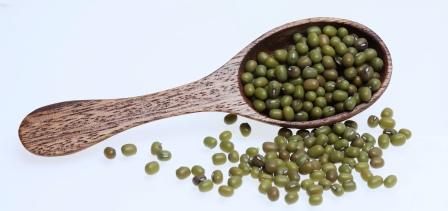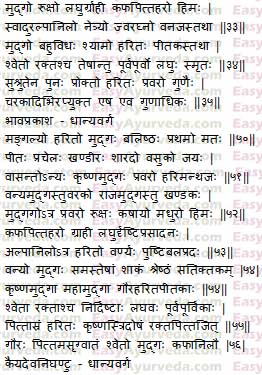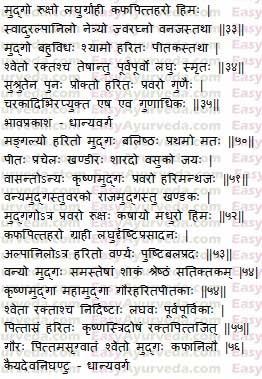Green Gram (Mung bean) Qualities, Uses, Remedies, Research

By Dr Renita D’Souza
Green gram is one among the daily recommended food mentioned in Ayurveda. The word ‘Mudga’ in Sanskrit is that which brings happiness. It is rich in Iron and Potassium. It is best among the group of pulses (shimbi dhanya).
Table of Contents
Benefits – introduction
Mung bean is the good rejuvenative and can be included in daily diet plate. It is used as both nutritional food and herbal medicine in many diseases conditions. Green gram soup is used as post panchakarma diet to strengthen the digestive fire and it is conducive to all ages of people. It is best used in most of diseases in the form of soup (mudga yusha).
Read – Soup Of Green Gram, Chickpea And Horse Gram – Health Benefits

Specialty of Mudga (moog) based on its physiological effect in the human body is that in-spite of being sweet in taste it is Laghu (light to digest) and ruksha (dry in nature) and it nourishes, promotes physical strength and builds the tissues. This property is called ‘Vichitra Pratyarabdha’ i.e green gram belongs to the category of substances possessing distinctive property ‘a unity of paradoxes’. Hence green gram have multiple action.
Read – Green Gram Ginger Vada – Method Of Preparation, Benefits
Botanical Name – Vigna radiata
Synonyms – Phaseolus aureus, Phaseolus radiatus L
Family – Leguminosae
Medicinal qualities
Medicinal Qualities of Green gram (mudga)
Taste – sweet
Vipaka (taste after digestion) – Pungent (Katu)
Ruksha – dry
Laghu – light to digest
Grahi – absorbent
Shitha – cold in potency
Vishada – clears the obstructed body channels, digestive and metabolic pathways
Special qualities of Mung bean
Drishta prasadana – good for eyes
Jwaragna – relieves fever
Varnya – improves skin complexion
Pushti bala prada – nourishes and increases physical strength
Read – Boondi Laddo, Motichoor Ladoo, Til Ke Laddu Method, Ayurvedic Benefits
Effect on doshas of Mung
Balances kapha and pitta dosha
Swalpa anilo – slightly aggravates vata dosha
Ayurvedic home remedies
By Dr MS Krishnamurthy
Skin detox
1. Fine powder of green gram (green gram flour) for tissue replenishing and skin detox:
The de-husked green gram is taken and fine powder is made. This is mixed with water and fine paste is made. This is applied over the face, like any of the face pack. On drying it is gently removed.
This replenishes the tissues and acts as skin detoxifier.
Green gram for skin care
Dry skin, bowel movement
2. Green gram soup for excess thirst, dryness of the skin and proper bowel habit:
The green gram soup prepared by adding little salt and pepper is taken regularly. This improves the hunger but pacifies the thirst. It relieves the dryness of the skin and proper bowel habit.
Erratic digestion
3. Butter milk cooked green gram for improper digestion:
The green gram with husk is cooked well with sour butter milk .This is macerated well and taken once, preferably in the evening. While cooking, pepper or dry ginger and little salt can be added. This improves the digestive capacity. Also it strengthens the gut. Also, it helps to form the stool in proper manner.
Sprouted moong dal with Turmeric pepper powder steamed with sesame oil is good to improve digestion strength. It is a famous remedy but Ayurveda does not recommend sprouted grains.
Energy drink
4. Decoction or medicated milk of roots of green gram as energy drink:
Fresh roots are taken and cooked with cow’s milk or else its decoction is made. To this little jaggery is added and taken. This acts as a good energy drink.
Green gram is a skin replenisher, natural body detoxifier and soothener of the body and mind. Small amount (30-40 gram) of green gram is taken with equal amount of Pomegranate seeds/fruits. This improves the strength of the intestine. Incorporation of the soaked green gram if taken along with green vegetables and as a component in green salad/veg salad surely one can observe its quick benefits within 7-10 days.
Soup
Green gram Soup (Mudga Yusha)
Green gram soup is prepared by boiling green gram in 14 parts of water till it obtains semisolid consistency. It can be added with salt or spices to improve the taste.
Read – Night Food Is Very Important. Watch What You Eat At Night.
Properties of Yusha
It kindles digestive fire, improves taste and appetite, aphrodisiac, improves the quality of voice, promotes physical strength and induces sudation.
Charaka’s remedies
Reference – Charaka Samhitha (A)
- Kaphaja Gulma – Soup of green gram and horse gram is useful
- Cough – Soup of green gram prepared with the decoction of Kantakari is sizzled and taken along with gooseberry and other sour substances.
- Vataraktha (gout) – Hot poultice prepared from green gram and milk cooked with decoction of vata alleviating herbs and added with fat is applied to relieve the pain.
- Herpes of Kapha origin – Decoction prepared from Snake gourd leaves, Green gram and Gooseberry juice must be taken by adding ghee.
- Wounds or Ulcers – Hot poultice prepared of Sesame, Green gram, Milk, Rice is applied to relieve pain and burning sensation.
Read – Ayurvedic Food Recipe For Kidney, Bladder Cleanse: Ashtaguna Manda
Green gram in diet
Green Gram as Wholesome Diet in Diseases
It is a beneficial and conducive diet in diseases conditions like
- Loss of appetite and taste,
- Gastritis
- Diarrhea, Vomiting, Irritable bowel syndrome, Dysentery
Read – Traditional Ayurvedic Diet Recipes For Dysentery And Diarrhoea - Diabetes
- Skin diseases
- Jaundice, Anemia
- Obesity
- Rhinitis, Cough, Asthma,Tuberculosis,
- Herpes
- Gynecological diseases
- Mental disorders
- Inflammation, Abscess, Fractures
- Piles, Fistula in ano
- Cardiac diseases
- Convulsions
- Vertigo, fainting
- Spondylitis , Arthritis, Gout etc
Types, varieties
Two forms of Green gram
Tusha (with husk) – Guru (heavy to digest)
Nishtusha (without husk) – Laghu (light to digest)
As per Ayurveda, green gram has 5 sub varieties and they are bluish black, green, yellow, white and red. The earlier ones are heavier in nature, orderly. Acharya Charaka and Sushruta have certified that the green ones are best among all varieties of green gram.
The pulses are rich in carbohydrate (54-56%) and protein (20-22%) content.
Varieties of Mudga (green gram)
According to Bhavaprakasha Nighantu – There are different varieties of green gram based on color. They are laghu i.e light to digest in decreasing order so that Shyama variety is more laghu and red is less light in nature.
Shyama (dark green or blackish)
Haritha (green)
Pita (yellow)
Shwetha (white)
Rakta (red)
As per Raja Nighantu
Green Variety –
Relieves pitta and blood related diseases
Black Variety –
Balances all three doshas and relieves bleeding diseases
Read – Ayurveda Mahodadhi: Legumes Green Gram, Chickpea, Peas
Mung Bean Increases Vata Dosha?
Green gram (mung bean) is said to increase Vata Dosha but green gram is also included in the list of ingredients that can be consumed daily. How?
Dr JV Hebbar
Lentils and dals will cause Vata to increase.
Eg: if they are cooked with sesame oil, then oiliness of sesame may counter the vata increasing quality of lentils and dals.
Whether a particular substance increases Vata or not depends largely on how it is processed and with what other ingredients.
It is true that green gram can increase Vata Dosha slightly.
मुद्गो रूक्षो लघुर्ग्राही कफपित्तहरो हिमः |
स्वादुरल्पानिलो नेत्र्यो ज्वरघ्नो
mudgo rūkṣo laghurgrāhī kaphapittaharo himaḥ |
svāduralpānilo netryo jvaraghno
Bhavaprakasha Nighantu, Dhanyavarga
Green gram is
rūkṣo – drying
laghu: – light to digest
grāhī – absorbent, useful in IBS,
kapha pitta haro – Balances Kapha and Pitta Odsha
himaḥ – Cooling
svādu – sweet
alpa anilo – slightly increases Vata Dosha
netryo – good for eyes
jvaraghno – useful in fever.
Mung bean (green gram) is also included in daily consumable food list.
षष्टिकाञ्छालिमुद्गांश्च सैन्धवामलके यवान्|
आन्तरीक्षं पयः सर्पिर्जाङ्गलं मधु चाभ्यसेत्||१२||
ṣaṣṭikāñchālimudgāṃśca saindhavāmalake yavān|
āntarīkṣaṃ payaḥ sarpirjāṅgalaṃ madhu cābhyaset||12||
Charaka Sutrasthana 5th chapter, 12th verse
ṣaṣṭikān shāli – Rice harvested in 60 days
mudgāṃśca – green gram
saindhava – rock salt
āmalake – amla fruit (Indian gooseberry)
yavān – barley
āntarīkṣaṃ payaḥ – water
sarpi – ghee
jāṅgalaṃ – meat of animals from moist regions, for non-vegetarians
madhu – honey
ca abhyaset – can be consumed every day.
Green gram is included here because of its high nutritive value and easy to digest nature.
So, why is green gram mentioned in the daily consumables, despite being slightly Vata increasing?
I see many western Ayurvedic students concentrating hard on these type of Vata diet, Pitta Diet, Kapha diet etc.
Though green gram can be slightly Vata increasing, it is not usually consumed alone. It is mixed with cooking oil, ghee, spices etc. to prepare kichdi etc. dishes.
Read: Ayurvedic Khichdi: How To Make? Benefits, Side Effects
The method of processing and ingredients used, especially mixing oil or ghee in the green gram dish would bring in the Vata balancing effect. So, though green gram is slightly Vata increasing, other ingredients of the dish would balance that out.
The final qualities and functions of a dish can be different from the original ingredients used.
Read: Local Foods, Cooked, Raw, Refrigerated Foods As Per Ayurveda
Nutritional value, chemistry
Nutritional Value of Moog
It is rich in carbohydrates and is a very good source for minerals like Potassium, Magnesium, Calcium, Phosphorus and Iron. Vitamins like Carotene, Thiamine, Niacin, Riboflavin, Ascorbic acid and Folic acid.
Chemical Constituents of Mung bean
It contains flavanoids (Flavones, isoflavones and isoflavonoids), phenolic acids (Gallic acid, Vanillic acid, Caffeic acid, Cinnamic acid, protocatechuic acid, Shikimic acid, p- hydroxybenzoic acid etc) and organic acids.
Sanskrit verse


Interaction with medicines, supplements
Can this be used while taking Homeopathic medicine?
Yes. This product does not react with homeopathic medicine.
Can
this medicine be continued while taking supplements like multivitamin tablets,
Omega 3 fatty acids etc?
Yes. Generally, this product goes well with most
of the dietary supplements. However, if you are taking more than one product
per day, please consult your doctor for an opinion.
With western
medicines
Seek your
doctor’s advice if you are taking this product along with other western
(allopathic / modern) medicines. Some Ayurvedic herbs can interact with modern
medicine.
If both Ayurvedic and allopathic medicines are advised together, then it is
best to take Allopathic medicine first, wait for 30 minutes and then take the
Ayurvedic medicine.
Morphology, research, categorization
Morphology of Green gram
Vigna radiata is an annual vine growing up to 1-2 feet in height. Stem have fine, brownish hair. Leaves are alternate, trifoliate. Flowers are greenish yellow in color. Fruit is pod. Seeds are globular, green in color.
Research
Nutritional and Therapeutic uses of Mudga – A review article describes important aspects of Green gram as an effective lifestyle intervention in various diseases.
Anti diabetic Activity – A study conducted to evaluate anti-diabetic activity of Aqueous extract of Vigna radiata in Streptozotocin induced diabetic mice have concluded that aqueous crude extract of v.radiata possesses a significant anti-diabetic activity.
Classical Categorization
Bhavaprakasha Nighantu – Dhanya varga
Kaiyadeva Nighantu – Dhanya varga
Dhanvantari Nighantu – Suvarnaadi Varga
Raja Nighantu – Shalyadi Varga
Shodala Nighantu – Shimbidhanya Varga
Distribution, Ayurvedic medicines
Distribution
It is cultivated in East Asia, Southeast Asia and Indian subcontinent.
Ayurvedic Medicines with Green gram as Ingredient
Galacto Plus Granules – Used to enhance breast milk production.
Migrakot Oil – Used in migraine and other forms of headache.
BAN Baby Oil – It is prepared by moisturizing oils to offer utmost care to the innocent skin of the baby. It is used in Feeble blood circulation, Neuromuscular debility, Scabies, Flabby, dry skin, Wrinkles, Rheumatoid arthritis, Osteoarthritis.
Kayasthadi Varti – Used in the Ayurvedic treatment of epilepsy, psychosis, mania, delusions, and such other neuro-psychiatric conditions.
Below, some market available sprouted products are explained. But please keep in mind that sprouted grains are not recommended as per Ayurveda. Read here to find out why
Mung beans, mature seeds, sprouted, raw
कषायमधुरो रूक्षः शीतः पाके कटुर्लघुः|
विशदः श्लेष्मपित्तघ्नो मुद्गः सूप्योत्तमो मतः||२३|| (Charaka samhita sutrasthana 27/23)
Taste – sweet, astringent
Properties – not very light, dry (mudga is light, but sprouted grains is said to be heavy according to Ayurveda)
Potency – cold
After digestion taste transformation ( Vipaka ) – pungent
Effect on Doshas
Vata increasing
Pitta balancing
Kapha nourishing (mudga is Kapha balancing, but since it is sprouted it increases kapha)
Mung beans, mature seeds, sprouted, cooked, boiled, drained, without salt
Taste – sweet, astringent
Properties – light, dry (sprouted mudga is said to be heavy but boiling and draining makes it light)
Potency – cold
After digestion taste transformation ( Vipaka ) – pungent
Effect on Doshas
Vata increasing
Pitta balancing
Kapha balancing (sprouted mudga is Kapha nourishing but since it becomes light on boiling and draining, it balances Kapha)
Mung beans, mature seeds, sprouted, cooked, stir-fried
Taste – sweet, astringent
Properties – not very light, dry (mudga is not very light, frying makes it lighter)
Potency – cold
After digestion taste transformation ( Vipaka ) – pungent
Effect on Doshas
Vata increasing
Pitta balancing
Kapha balancing
Mung beans, mature seeds, sprouted, canned, drained solids
Rasa – sweet, astringent
Guna – light, dry (sprouted mudga is said to be heavy but boiling and draining makes it light)
Veerya – cold
Vipaka – pungent
Effect on Doshas
Vata increasing
Pitta balancing
Kapha balancing (sprouted mudga is Kapha nourishing but since it becomes light on boiling and draining, it balances Kapha)
Mung beans, mature seeds, sprouted, cooked, boiled, drained, with salt
Rasa – sweet, astringent, slightly salty
Guna – light, dry (sprouted mudga is said to be heavy but boiling and draining makes it light)
Veerya – not very cold (salt is hot in potency)
Vipaka – pungent
Effect on Doshas
Vata increasing
Pitta nourishing (salt is Pittakara)
Kapha balancing (sprouted mudga is Kapha nourishing but since it becomes light on boiling an draining, it balances Kapha)
Vernacular names
Names in different languages
Sanskrit Name – Mudga
English Name – Green gram, Mung bean
Hindi Name – Moong, Mung
Kannada Name – Hesaru, Hesurubelae
Marati Name – Moog, Hirve moog
Bengali Name – Moog
Gujarati Name – Mag, Kachchi, Muga
Konkani Name – Moog
Telugu Name – Pacha pesalu, Pesaru pappu, Pesalu
Tamil Name – Pacaiymeru, Pachai parupu, Payatham paruppu, Pasipayir
Malayalam Name – Cherupayaru
Punjabi Name – Mung, Moongi
Kashmiri Name – Muang
Click to Consult Dr Renita D’Souza











4 comments
prezio
dear sir can you please suggest me if the yellow moong bean halwa made with ghee,milk,cardamom,raisins,almond is good for vata people? , and can help to weight gain ?
Dr J V Hebbar MD(Ayu)Author
Yes, it is good.
Bharat
What kind of grams are good for Vata dosha sir?
Dr J V Hebbar MD(Ayu)Author
Black gram.